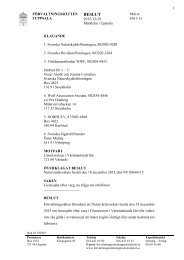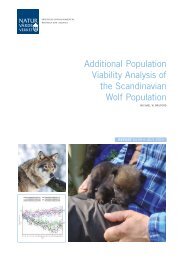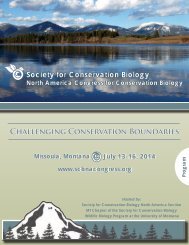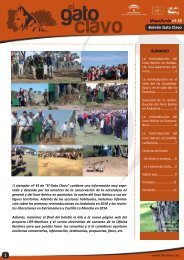1oC3Dbk
1oC3Dbk
1oC3Dbk
Create successful ePaper yourself
Turn your PDF publications into a flip-book with our unique Google optimized e-Paper software.
stakeholders, including Plantlife International and the SSC Cat<br />
Specialist Group, working with the IUCN Office South-eastern<br />
Europe, have been tracking the implementation of<br />
Recommendation 150 – Protecting Mavrovo National Park<br />
Macedonia (FYR). This site is still threatened by planned large<br />
dams, and there have been meetings with the European Bank<br />
for Reconstruction and Development, a potential investor in<br />
these dams, on the reasons why it is important to safeguard<br />
this remarkable site. The SSC/Wetlands International Crane<br />
Specialist Group is continuing to track the implementation of<br />
Recommendation 154 – Conservation of Poyang Lake,<br />
People’s Republic of China.<br />
Sun Bear (Helarctos malayanus) Vulnerable. © Michelle Bender<br />
long term monitoring of Chinese black bear populations and<br />
poaching impacts on them. It was also agreed that achieving<br />
the above goal would require distinguishing between the three<br />
possible relationships between the legal and illegal trade:<br />
positive, neutral and negative. For each of these, there is one<br />
or more hypotheses regarding the way the legal trade affects<br />
the illegal trade (and thereby wild bear poaching and<br />
conservation) as follows:<br />
• Bear farming is positive for wild bears<br />
– Availability of legal bile removes a proportion of potential<br />
customers from the pool that would buy wild bile at current<br />
prices<br />
• Bear farming is neutral for wild bears<br />
– Consumers of farmed and wild bile are separate market<br />
sectors and if farmed sources were not available those<br />
consumers would no longer buy bear bile<br />
• Bear farming is negative for wild bears<br />
– Legal bile increase risk of laundering wild bile<br />
– Availability of legal bile makes it easier for sellers of illegal<br />
bile to find buyers<br />
– Availability of legal bile makes buying wild bile more<br />
acceptable<br />
– Availability of legal bile means that legal users, after using<br />
legal product, are more likely to be interested in trying wild<br />
bile<br />
– Availability of legal bile enables marketing of legal product,<br />
which increases demand for both legal and illegal.<br />
Work is now progressing to establish two Working Groups to<br />
implement the situation analysis: 1) Bear Breeding and Bile<br />
Product Trade; and 2) Evaluation of the trend of Wild Bear<br />
Populations. Each Working Group will be composed of<br />
participants nominated by SFA and IUCN. Dave Garshelis is<br />
the overall lead for IUCN. In addition to agreeing the<br />
composition of the Working Groups, there now needs to be a<br />
major push on fund-raising to initiate work on the situation<br />
analysis.<br />
Follow-up has taken place on many other Resolutions from the<br />
Jeju Congress. For example, the SSC Horseshoe Crab<br />
Specialist Group is working with government agencies to<br />
prevent the importation of Asian horseshoe crabs as bait to<br />
the United States, thus partially addressing Resolution 030 –<br />
The Conservation of Asian Horseshoe Crabs. A number of<br />
Work has continued on developing SSC policies and<br />
guidelines. The SSC Wildlife Health Specialist Group (WHSG)<br />
has led on the development of new IUCN Guidelines for<br />
Disease Risk Analysis, working with the Conservation<br />
Breeding, Invasive Species and Reintroduction Specialist<br />
Groups. The Guidelines were reviewed by the wider SSC, and<br />
after the incorporation of changes, the final version was<br />
adopted by the SSC Steering Committee in early June 2013.<br />
Richard Jakob-Hoff from Auckland Zoo, New Zealand, led the<br />
process to develop these Guidelines. Accompanying these<br />
Guidelines is a Disease Risk Manual on which the WHSG is<br />
also leading. Both the Guidelines and the Manual are being<br />
published in collaboration with the World Organisation for<br />
Animal Health (OIE), which is generously covering the<br />
production costs.<br />
At the same time, the SSC Conservation Breeding Specialist<br />
Group is close to completing its work on the new revised<br />
Guidelines on Ex-Situ Management. These have now been<br />
reviewed by the SSC membership, and the Steering<br />
Committee will review and adopt the final version soon. For<br />
some time it has been recognized that the IUCN Guidelines for<br />
the Placement of Confiscated Animals, which were approved<br />
in 2000, need to be updated but until now no-one has come<br />
forward to head up this process. However, Neil Madison from<br />
Bristol Zoo, UK, has agreed to lead the process to revise the<br />
2000 Guidelines, and work will start on this shortly. A new<br />
process has been launched to develop IUCN Guidelines for<br />
Minimizing Negative Impacts of Guano Harvesting. This<br />
process is being led by Ryan Richards. There are also plans to<br />
develop a Policy on Intentional Genetic Manipulations of Wild<br />
Species, but these are still at an early stage.<br />
As usual, interventions have been made on pressing<br />
conservation issues as they arise, including the following:<br />
• On 28 May, at the request of the SSC Iguana Specialist<br />
Group, the Director General wrote to the Minister of Water,<br />
Land, Environment and Climate Change in Jamaica to<br />
express concern and offer assistance with regard to the<br />
illegal collecting of wood for charcoal within the range of the<br />
Critically Endangered Jamaican Iguana. Unfortunately this<br />
letter does not appear to have had the desired effect, and<br />
threats to the site of the Jamaican Iguana are growing, and<br />
so consideration is being given to making a high-level<br />
intervention on this topic.<br />
• On 25 June, at the request of the SSC Antelope Specialist<br />
Group, the Director General wrote to H.E. José Eduardo dos<br />
Santos, president of the Republic of Angola, concerning<br />
urgent measures to save the Giant Sable (which is the<br />
national animal of Angola) from extinction.<br />
Addressing Critical Conservation Issues<br />
23






